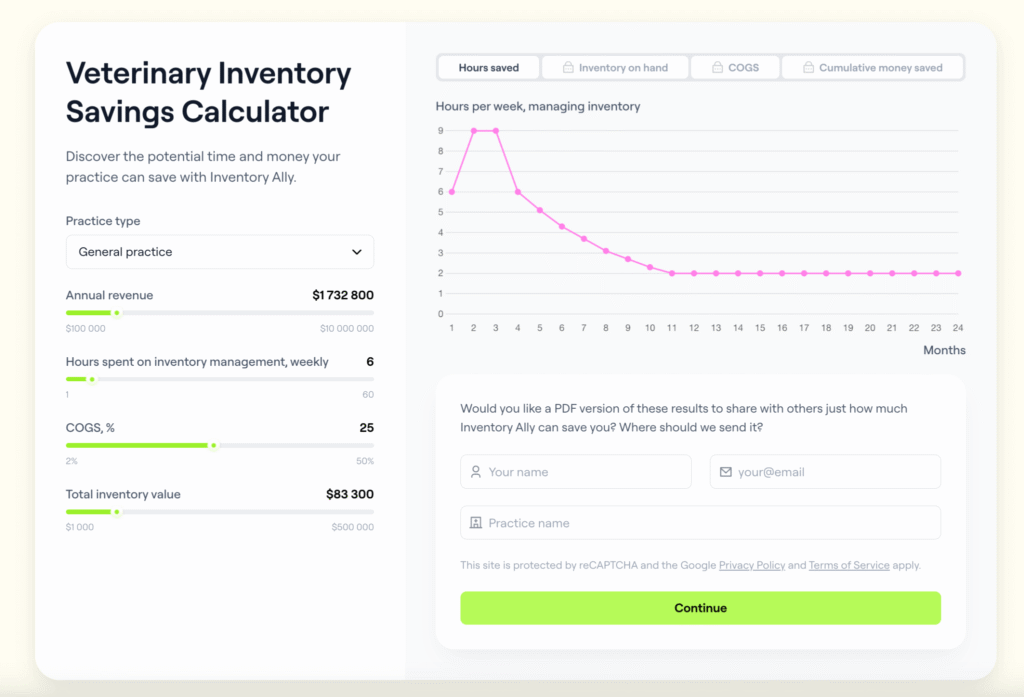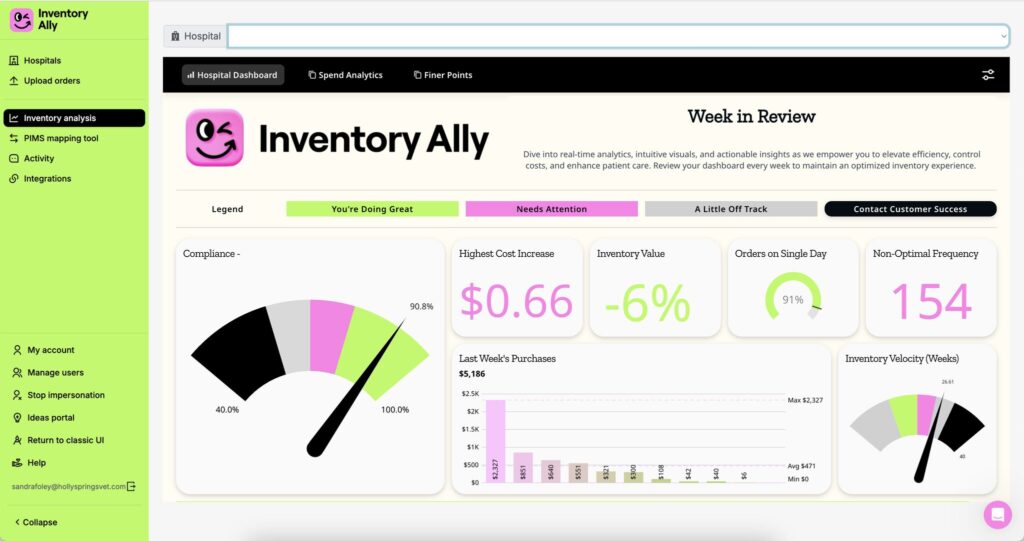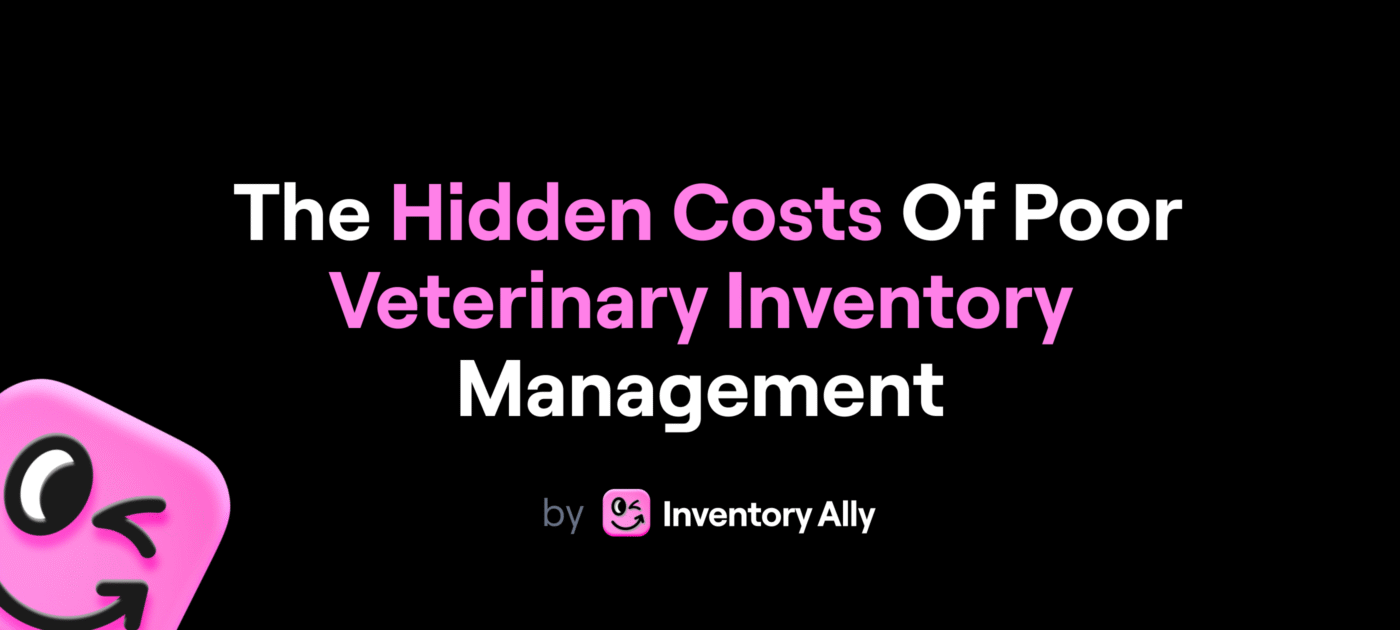Inventory management may not be the most visible part of running a veterinary practice, but it’s one of the most essential, and often overlooked, drivers of a smooth, successful clinic.
A strong inventory system quietly supports everything from daily workflows to patient care and financial health. When it’s running well, your team moves efficiently, patients get what they need, and your numbers stay on track. But when it slips, the impact tends to show up everywhere — from your workflow to your wallet.
The truth is, poor inventory management doesn’t just mean the occasional stockout or messy shelf. It can ripple across your entire clinic, leading to financial waste, workflow breakdowns, frustrated teams, and even missed care opportunities for your patients.
In this article, we’ll shine a light on the hidden costs lurking behind disorganized or outdated inventory systems and show you how to take back control (without spending your weekends buried in spreadsheets).
Spoiler alert: It’s easier than you think with the right tools.
1. Financial Drain: The Unseen Expense
Let’s start with the obvious (but often underestimated): inventory is expensive. In most practices, it’s the second-largest expense after payroll.
Without a clear system in place, costs can balloon fast. You’re ordering reactively, sitting on products you don’t need, running out of ones you do, and spending way more time than anyone wants to admit chasing down invoices and packing slips. That “just-in-case” backstock? It’s quietly draining your cash flow.
And then there’s the hidden stuff. The holding costs — storage space, insurance, spoilage, depreciation — that tack on an extra 8–15% to every item sitting on your shelf. The shrinkage — expired products, damaged goods, mysteriously disappearing meds that never get used, never get billed, and never show up in your P&L (until they do).
When your inventory isn’t optimized, every one of those costs adds up — and fast.
Want to see how much inefficient inventory might be costing you? Try our Veterinary Inventory Savings Calculator to get a quick snapshot.

Read how other practices are cutting costs with smarter inventory:
- Todd County Animal Clinic reduced their COGS from 43% to 31.9% in just one month →
- Metz Petz slashed their COGS by 6% with Inventory Ally →
2. Operational Inefficiencies
Inventory issues don’t just cost money, they also cost time. And in a busy veterinary clinic, time is everything.
When your team is hunting for missing supplies, double-checking what’s already been ordered, or trying to find an alternative to a product in short supply, that’s time not spent with patients. The workflow gets clunky. The stress builds. And suddenly, what should be a simple refill feels like a full-on crisis.
Then come the emergency orders. The “we-need-it-tomorrow” kind that throw off your day, result in higher shipping costs, and create unnecessary chaos. These issues usually happen because there’s no system flagging when stock is running low until it’s too late, or because there’s no accurate way to forecast true demand.
At the same time, many practices end up overstocking in an attempt to avoid these situations, tying up cash in shelves full of “just in case” items that may expire before they’re used. It’s a balancing act that’s hard to maintain without a solid system.
It doesn’t have to be complicated:
Start with clear reorder points, track what’s actually being used, and set up a routine for reviewing inventory data regularly. The more proactive your process, the fewer surprises you’ll run into.If you want a deeper dive on setting reorder points, Nicole Clausen (Inventory Ally’s co-founder) wrote a great practical guide: Guide to Not Running Out. It walks through different types of reorder systems and includes real examples.
Inventory Ally simplifies this by:
- Predictive ordering that factors in your historical usage
- Real-time visibility into what’s on hand, what’s running low, and what’s on the way
- Custom reorder points that alert you before it becomes an emergency.
Transform Your Inventory Management
Reduce inventory costs, save time, and minimize stockouts
3. Compromised Patient Care
When inventory breaks down, patient care doesn’t just stall — it suffers.
Running out of a key medication, a diagnostic test, or even something as simple as IV lines can delay treatment and force teams into workarounds that aren’t ideal. And when the tools you need aren’t there when you need them, it adds stress to an already high-stakes environment.
These delays don’t go unnoticed by clients, either. They may not know the details of your ordering system, but they absolutely feel the ripple effect — whether it’s a longer wait time, a rescheduled appointment, or the uncomfortable moment when you have to say, “We’re out of that right now”.
Over time, these moments chip away at trust. And in a service environment, trust is everything.
Inventory Ally supports this by:
- Giving you real-time visibility into what’s in stock across all categories
- Flagging low inventory before it becomes a care delay
- Helping your team stay focused on patients, not admin work.
When inventory runs smoothly behind the scenes, your team gets to show up with confidence, and your clients see a practice that’s organized, prepared, and always ready to provide care.
4. Staff Morale and Retention
Inventory may seem like a background task, but when it’s off, it can quickly become a daily source of stress for your team.
From scrambling to find missing supplies to juggling manual order lists or dealing with unhappy clients when something’s out of stock, these small moments add up. And when the system feels broken, it’s easy for staff to feel like they’re the ones falling short.
Over time, this contributes to burnout, especially for those team members who are working hard to keep inventory in check, often without the systems and support they deserve.
Turnover compounds the problem. New team members are left guessing where things go, how ordering works, or who’s responsible for what, leading to more errors, more frustration, and even more turnover. This article takes a closer look at how poor inventory systems can contribute to staff turnover.
Here’s how to ease the burden:
- Document key inventory processes (like ordering, receiving, and tracking usage) so they’re easy to follow and hand off
- Assign clear roles — inventory works best when responsibility is shared and supported, not siloed.
- Create a basic training resource or checklist to help new team members get up to speed quickly.
If you’re not sure where to start, our guide to key roles and responsibilities breaks it down in a really approachable way.
Inventory Ally makes this even easier by:
- Standardizing inventory workflows across team members
- Making delegation simple with user roles and access controls
- Providing clear visibility into what’s running low, what’s been ordered, and what needs attention, eliminating any guesswork.
When your inventory system supports your team, not the other way around, you don’t just reduce stress, you build a workplace people want to stay in.
5. Impact on Practice Valuation
If you’re thinking about selling your practice or just building a healthier business, inventory management is one of the first things to consider.
Poor inventory systems inflate expenses and quietly drag down profitability. Overstock, shrinkage, emergency orders, and missed charges can all distort your financial picture. And since inventory is one of the top expenses in a clinic, even small inefficiencies can have an outsized impact.
It’s not just about numbers, either. When potential buyers or investors assess a practice, they’re looking at the whole operation. Disorganized inventory can signal deeper issues, like a lack of systems, inconsistent processes, or undertrained staff. Even if you’re delivering great patient care, high COGS can raise red flags.
Here’s how to protect your valuation:
- Review your Cost of Goods Sold (COGS) regularly and benchmark it against similar practices
- Implement systems to reduce waste, catch missed charges, and avoid over-ordering
- Track your inventory accuracy over time — it’s a key indicator of how well your operations are running.
Inventory Ally supports growing practices by:
- Helping reduce COGS through optimized ordering and predictive analytics
- Providing clean, easy-to-share reporting for financial reviews or due diligence
- Creating consistent, documented processes that strengthen day-to-day operations and long-term value.
Whether or not you’re planning to sell, your inventory system should support your goals, not work against them!
Making Inventory Work Better
Every hidden cost we’ve covered — lost revenue, wasted time, treatment delays, team burnout, and valuation risk — traces back to inventory systems that quietly drain resources and hold practices back, rather than supporting long-term sustainability and profitability.

Inventory Ally was built to change that.
It’s a cloud-based inventory management platform designed specifically for veterinary teams. Instead of piecing together spreadsheets, guesswork, and constant manual checks, Inventory Ally gives practices the structure, visibility, and automation you need to take control.
Here’s what that looks like in action:
- Cost Reduction
Practices have reported up to a 30% decrease in inventory carrying costs within the first 12 weeks of implementation. - Time Savings
With automated processes and an intuitive interface, staff can reclaim 3–7 hours per week, freeing them to focus on patient care, not inventory chaos. - Enhanced Profitability
Optimized inventory levels and reduced waste help clinics improve margins and reinvest savings into growth and care. - Operational Efficiency
Real-time tracking and proactive alerts replace manual checks, reducing errors and helping your team stay ahead.
Inventory Ally integrates seamlessly with PIMS like ezyVet, Digitail, Provet Cloud, Avimark, Covetrus Pulse, and more, working right alongside the tools your team already uses.
Whether you’re managing a single-location practice or a multi-site network, Inventory Ally gives you the tools to streamline inventory, strengthen your operations, and uncover savings hiding in plain sight.
Conclusion
Inventory quietly supports every aspect of your clinic, and when it’s not working, everything feels harder.
From financial waste and workflow breakdowns to team burnout and missed care opportunities, the hidden costs of poor inventory management show up in every corner of your practice. And left unchecked, they can quietly chip away at profitability, client trust, and long-term growth.
But the good news? These are fixable problems — with the right systems, tools, and a little intention.
Whether you’re tightening up your current process or ready to level up entirely, investing in better inventory management isn’t just about avoiding stockouts. It’s about building a smoother, more sustainable practice. One where your team has what they need, when they need it, and your business has the numbers to show for it.
Ready to see what’s possible with smarter inventory?
Start with our Veterinary Inventory Savings Calculator or book a walkthrough of Inventory Ally to see how it fits your practice.

